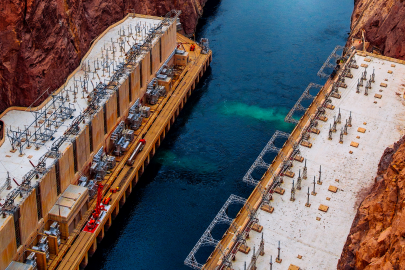On World Ocean Day, WPTO Director Jennifer Garson discusses the incredible power and potential of our oceans and WPTO’s research on new ways to harness this resource to generate clean electricity.
Water Power Technologies Office
June 8, 2022On this World Ocean Day, we recognize the incredible power and potential of our oceans. At the U.S. Department of Energy’s Water Power Technologies Office (WPTO), we are performing vital research and exploring new ways to harness this resource by converting the power in waves, tides, and ocean and river currents into clean electricity. These efforts will help our nation transition to a clean energy economy while supporting coastal communities and protecting the environment.
For example, we support researchers who are developing new marine-energy-powered ocean sensors that track the health and wellbeing of our ocean’s wildlife and bobbing buoys that scan for signs of the next big storm. Through our Ocean Observing Prize, competitors are figuring out new ways to monitor hurricanes by uniting wave- and current-powered systems with ocean observing technologies.
Prize teams have spent the last three years reimagining everything from weather buoys to uncrewed underwater vehicles. Their ocean-bound, ocean-powered devices can lengthen voyages at sea all while protecting the waters they monitor. Longer expeditions mean more coverage, offering better and more timely data to warn coastal cities and island towns when signs indicate a hurricane might be brewing. With climate disasters costing the United States about $148.4 billion annually, these devices have the potential to save both lives and money.
In a recent Ocean Observing Prize video, Carl Gouldman, director of the U.S. Integrated Ocean Observing System Office at the National Oceanic and Atmospheric Administration and one of our partners on the prize, said it best: “Without new technologies to power our observing systems, we can’t get the coverage we need. We can’t get the answers to the questions we have. That’s why we need the types of technologies this prize can generate.”
Yet even with enhanced ocean observing technologies and early warning systems, these storms can still cause widespread damage. In those scenarios, ocean waves can support another way: small, portable marine energy devices can generate fresh drinking water from the ocean for communities while they recover and rebuild.
Ocean observing is just one member of a vast fleet of growing opportunities in the blue economy. The ocean is powerful—that’s clear from the storms it births. Its power also surfaces in other ways, supporting millions of jobs and supplying at least half of the world’s oxygen. As an example, U.S. aquaculture—or ocean farming for fish, oysters, clams, and even seaweed—produces $1.5 billion worth of seafood and supports 1.7 million jobs every year.
The blue economy is big—and growing. In 2019, the U.S. marine economy grew faster than the nation’s economy as a whole. From international shipping to aquaculture and marine research, marine industries are booming, which means protecting this vital resource and its wildlife and ecosystems is perhaps more important than ever.
WPTO is helping to make that happen. As part of our vast research and development efforts, we support researchers designing new technologies that generate clean power—like those developing cutting-edge floating generators that transform waves into power. Technologies like this could provide clean energy for offshore activities, including oceanographic research and desalination.
Marine energy technologies can, eventually, help coastal and remote island communities both sustainably grow the blue economy and protect our oceans at the same time. The ocean holds power, mysteries, and vast opportunities. Now, with WPTO’s support, scientists are designing pollution-free ways to study, work, and live alongside this great and valuable resource.
Jennifer Garson

Jennifer is the Director of the Water Power Technologies Office at the U.S. Department of Energy, where she leads the office’s strategy, management, and execution of the $150M office. The Water Power Technologies Office advances research, development and demonstration of hydropower and marine renewable energy. For the last three years, she has led some of the office’s key activities and initiatives—like the Powering the Blue Economy initiative—and a portfolio of prizes, interagency grants, among other programs. She has focused on increasing the impact of federal funding for supporting innovation, including leveraging nontraditional financial mechanisms. This includes increasing the utilization of prizes, creative lab-directed funding, SBIR/STTRs, and other competitive solicitations. Over the last decade, she has worked across DOE, the federal government, and in partnership with the private sector to launch and create new programs, prizes, and commercialization approaches for blue economy and cleantech technologies and applications.
Prior to the Water Office, she was the Chief of Staff for the Deputy Assistant Secretary for Renewable Power in the Office of Energy Efficiency and Renewable Energy. She was previously a Senior Advisor for the U.S. Department of Energy Office of Technology Transitions, focused on Department-wide strategies for increasing the use of prizes, challenges, and other open innovation tools. She also focused on catalyzing new networks and prizes to help entrepreneurs move their technologies from research institutions into the market in the Office of Energy Efficiency and Renewable Energy Technology to Market team. Her programs supported hundreds of startups across the country through novel training programs, competitions targeted at university students, challenges linking solutions to major corporate partners, supporting early-stage pilots helping validate companies' technologies, and creating new national and regional networks.
She served as a policy and market analyst in the Office of the Chief Financial Officer, developed analysis and provided technical assistance for the Office of Electricity Delivery and Energy Reliability on their smart grid portfolio during the Recovery Act, and served as a research assistant for a private consulting company.
Jennifer earned her B.A. in Anthropology and Environmental Studies Concentration at Kenyon College and her Master of Public Policy at George Washington University.
Articles by Jennifer Garson
-
 This National Hydropower Day, explore ways WPTO is helping build cleaner communities and making important contributions toward the United States’ goals of achieving a carbon-free electricity sector by 2035 and net-zero-emissions economy by 2050.
This National Hydropower Day, explore ways WPTO is helping build cleaner communities and making important contributions toward the United States’ goals of achieving a carbon-free electricity sector by 2035 and net-zero-emissions economy by 2050. -
 WPTO Director Jennifer Garson discusses WPTO’s investments in efforts led by industry, academia, and our national laboratories to advance our understanding and development of water power systems and technologies.
WPTO Director Jennifer Garson discusses WPTO’s investments in efforts led by industry, academia, and our national laboratories to advance our understanding and development of water power systems and technologies. -
 Water Power Technologies Office (WPTO) Director Jennifer Garson presents the 2020-2021 WPTO Accomplishments Report, which highlights achievements from WPTO-supported research across its Hydropower and Marine Energy programs.
Water Power Technologies Office (WPTO) Director Jennifer Garson presents the 2020-2021 WPTO Accomplishments Report, which highlights achievements from WPTO-supported research across its Hydropower and Marine Energy programs. -
WPTO is working harder to protect, understand, and leverage the immense power and promise of the ocean.
-
The Cleantech University Prize Collegiate Competition has traveled coast-to-coast over the past four months to find America’s next clean energy entrepreneurs. Meet the teams that will compete for $100,000 in prizes at the National Competition this we...
-
Energy Department competition supports student entrepreneurs and helps spur development of new clean energy technologies.
-
The Cleantech University Prize recently made two stops along the Interstate 95 corridor, with regional competitions in New Jersey and Boston. With just two regional competitions remaining, Cleantech UP teams are inching closer to the national competiti...
-
Forty-two companies with promising energy and other cutting-edge technologies collected more than $1.69 million at the 2016 Rice Business Plan Competition in Houston, Texas, capping an annual event billed as the world’s richest and largest graduate-l...
-
NovoMoto, a student-led startup from the University of Wisconsin-Madison, took home $50,000 after winning the Energy Department's Cleantech University Prize regional competition at the annual Clean Energy Trust Challenge in Chicago. NovoMoto's MicroPla...
-
The Energy Department's Cleantech University Prize competition traveled to the campus of Carnegie Mellon University in Pittsburgh for the first-eve...
-
Heating and air conditioning -- an $11 billion industry in America -- accounts for 5% of domestic energy use.

